Review: LCD Projector
Epson Dreamio EMP-TW600 /
Epson PowerLite
Cinema 550
Allround TV and Film Projector with sleek Design -
"Living Room Home Theater Projector of the Year"
The choice of inexpensive home theater projectors continues to increase. Particularly with LCD projectors, ever more manufacturers have recognized the market potential of the large picture at home. But the technical development is expensive, which is why most manufacturers use the LCDs of one manufacturer: Epson. The current model is the "D5" series with a native "HD-ready" resolution of 1280 x 720 pixels. But Epson does not only sell the LCD's to other manufacturers, it also produces its own home theater products. The well-known Epson EMP-TW200 might be a familiar term for many.

It has taken a long time before its successor was released, but for a few weeks its here. Epson would like to tie in to the quality of its much appraised predecessor with the EMP-TW600 / Cinema 550. Whether or not they were successful we will examine in this extraordinarily elaborate review, which at the same time completes our LCD review series.
We would like to refer in advance to our test criteria, which are described in our Know How Special: "Projectors / Plasma TV's - Quality aspects".
1. Equipment and Technology (Know How Link here)
Not long ago projectors were mostly dull grey or black boxes, which offered very little with regard to exterior design. Fortunately this has changed lately. But while many manufacturers approach their design very conservatively, the Epson designers show much courage to obtain individuality.

The rounded housing without edges and corners, but with flowing lines shows a certain similarity to its predecessor but still manages to maintain its own style, which is very unique in home theater products. The white housing color with the silver front is modern and suitable for many living rooms. Without a doubt the TW600 / 550 is a real eye catcher, whether it is on the table or suspended on the ceiling.

The choice of materials is appropriate for its price range, but sadly does not leave a very "high-end" impression. As with its predecessor, not precisely fitting seams here and there disturb the otherwise high quality feel of the machine.

Nevertheless the individual design of the TW600 / 550 is sure to make many friends. Taste can not be argued about, but the projector has scored many points with customers since its release with regard to its design.
1.1 Technology (Know How Link here)
Exterior design is only secondary, what really counts are the inner workings, i.e. the technical realization and the actual picture quality. The TW200 was extremely exemplary in this respect, apart from its missing digital input. Again we have opened up the housing in order to grant our readers a look behind the curtains.
After opening the upper lid a common sight appears: the signal electronics covers the optical path like a lid.

Inside of the TW600 / 550
Its heart is, like in nearly every LCD projector, a current Pixelworks signal processor. No surprises here. Worth mentioning however is the 10 bit video processing, which is to ensure an accurate color production without artifacts.

Top and bottom of the "beautiful green" main board.

After the main board has been removed, the optical structure appears, which in the case of the TW600 / 550 shows both innovations and surprises.

The optical path in picture and scetch

A real change compared to its predecessor is the integrated adaptive iris,
which is used in all modern home theater LCD projectors.
"Invented" by Sony and Panasonic, Epson has now also picked up this idea and created their own solution. The adaptive iris is placed in the beginning of the optical path, directly behind the projection lamp.

The technical realization is astonishingly close to the Panasonic-solution:

Above: The Panasonic iris
Below: Epson's solution

The adaptive iris can control the light flow of the bulb by opening and closing the swinging doors. The iris closes on scenes with little light and much black until only a slight gap remains for light to pass.

The closed iris
With bright scenes however the doors swing open to a horizontal position, opening the light window to the max and enough light is beamed into the optical path:
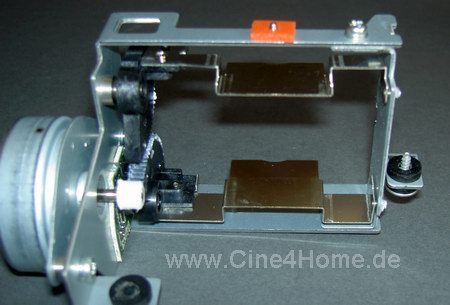
Opened iris
As we already explained in many reviews, the adaptive iris can certainly be an advantage for the image representation. Important with this however is its programming and response time. The large stepper motor driving the iris seems a little ponderous, but in the picture test we will examine and explain the impact on the picture in detail.
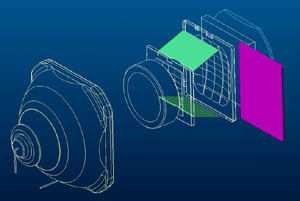
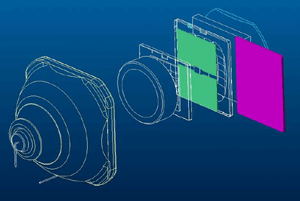
Descriptive sketch of the operation of the adaptive iris.
The second contrast-increasing technical solution can still only by found with Epson: an insertable color filter in the optical path. Also its predecessor, the TW200, used a similar technology with astounding results. With the TW200's successor however the technical conversion was realized differently. While a cyan-filter was used with the TW200 which adjusted the remaining Green and Blue colors after the semi-permeable mirror, the TW600 / 550 utilizes a Red/Blue (Pink) filter placed directly in front of the lamp behind the adaptive iris.

The built-in color filter of the TW600 / 550
The picture above shows the high quality filter of the projector. Its cyan color is deceptive: the camera absorbs only the reflecting light portions of the filter. Because the filter passes red primarily, it reflects Green and Blue (cyan) which lends it its turqoise glow.
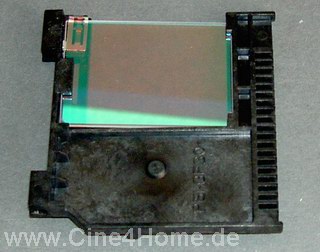
The filter is not locked into the light path, but can be inserted by the user if needed by remote control! A small motor is used to push the filter in front of the light bulb, like a slide.
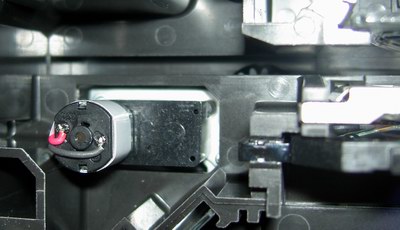
Above: the motor in close up
Below: the position of the filter construction relative to the lamp

What's the principle behind the filter? As regular readers of our website know, video projection requires a relatively warm light with a color temperature of 6500K (D65). The UHP lamp technology currently used however produces a "native" light with more blue and green than red. Unaltered, this cool lamp light is not suited for accurate color reproduction: it has to be post-corrected. With almost all projectors the correction is done with the LCD-panels, thereby clearly reducing maximum brightness and with that contrast.

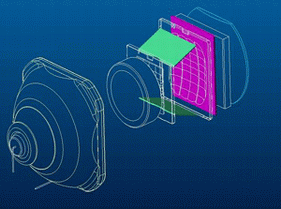
The filter is optionally placed in the light path
The alternative is an optical filter, which corrects the light to 6500K and equally reduces the brightness in white and black, so that no contrast loss has to be taken into account. This is exactly the same principle used with the well known "Projector-Tuning", on which we regularly have reported for quite some time now and which more and more specialist dealers include in their service.
But in the case of the TW600 / Cinema 550 the projector tuning has been integrated by factory, which makes post-adjustments with an external color filter unnecessary. And the motorization clearly offers a luxury opposed to the traditional tuning variant. If and how the color filter affects the picture positively, we will examine further in our picture test.
The remaining structure of the optical path brings no further surprises. As always, half-permeable mirrors splice the basic colors consecutively and guide it onto the corresponding LCD panel.
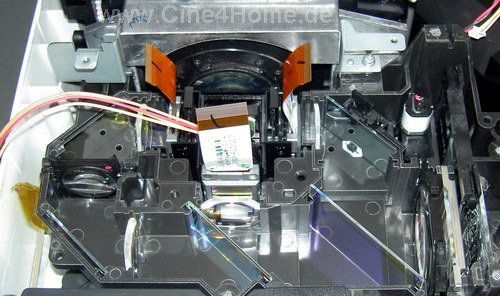
Above: the entire optical path
Below: the coloration of the glass can clearly be seen
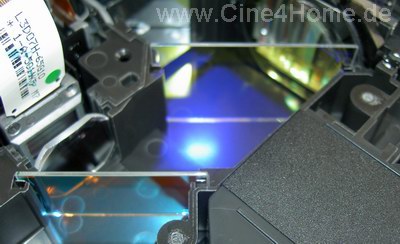
The individual LCD's provide the actual light modulation. The light is polarized, reflected or passed by the LCD, and afterwards the three basic colors are layered on top of each other again by a glass prism, and leave the optics as a single color picture.
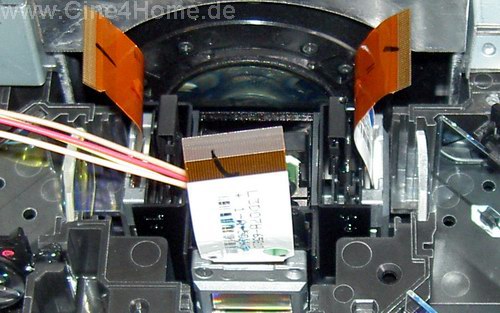
The optical block of the TW600 / 550
Remarkable is the large temperature sensor on the glass prism: a certain temperature control was apparently integrated to prevent damage to the sensitive optical components from overheating.
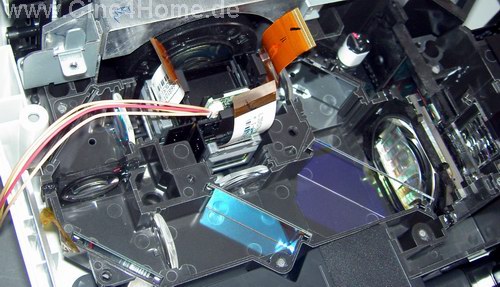
The temperature sensor with its cables is recognized on the prism.
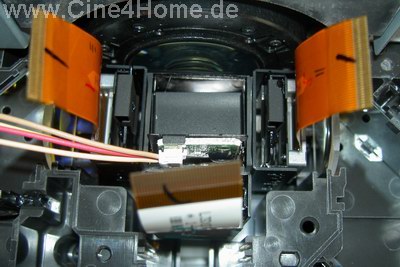
Equally clear are the polarizing filters in front of the LCD panels. They are
dyed like those of the Sony VPL-HS60, probably to improve the contrast characteristics of the projector.
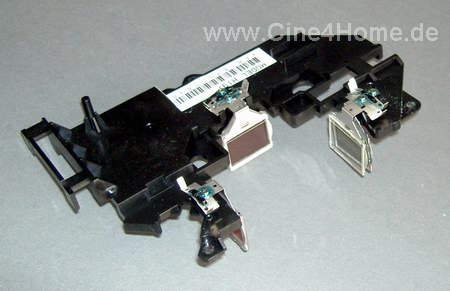
The polarizing filters in front of the LCD panels,
the different colors can be recognized.

Altogether, the light path of the TW600 / 550 is well thought through and technically mature. After this first impression we are confident that the picture quality will prove to be equally positive, but more on that in the third chapter.
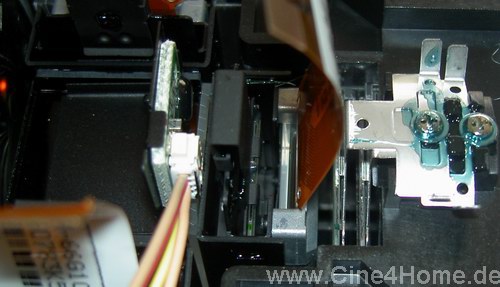
Close-up of an LCD panel with the polarizing filter in front
No matter how good the construction, without the appropriate light source the screen will remain dark. Epson again went their own way and presents the special "E-TORL"-lamp (Twin Optimized Reflection Lamp) with 170 Watts of power in the TW600 / 550.

Epson's E-TORL lamp
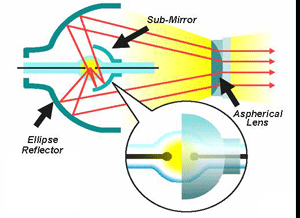

The advantages of the E-TORL technology are said to be: smaller dimensions, less heat waste and higher light output due to fewer losses. Up to 1600 Lumen should the TW600 / 550 reach with the new lamp. This is a high value, which no other entry level LCD projector offers at the moment.
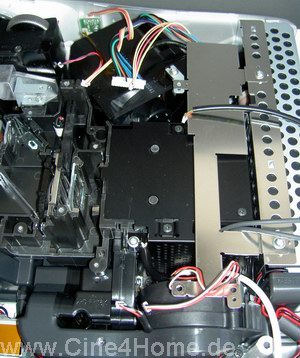
The lamp pit inside the machine
The lamp has a life span of up to 3000 hrs., which permits a cost-effective
use of the projector. No need to lose sleep over every "wasted" hour, especially because a spare lamp is offered exclusively by authorized specialist dealers together with Epson on purchase of the EUR 1699,-- machine (in Germany).
Should an exchange of the lamp be necessary, this can be done on the bottom of the projector.
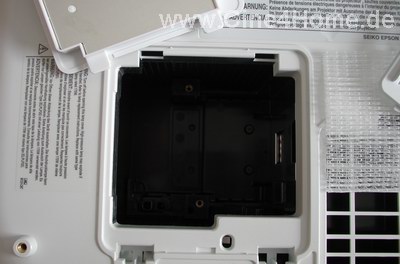
After loosening a few screws, the lamp module can be exchanged. Placement of the lamp pit on the bottom of the machine is less fortunate however. This means the projector has to be taken down if mounted on the ceiling.

Above: the empty lamp pit with a view on the first integration optics
Below: the lens from the "inside"
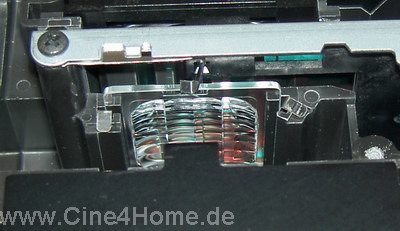
Complicated optic construction right at the beginning:
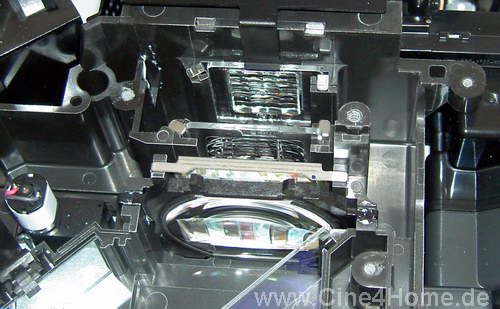
Even when the new lamp technology promises more light output, it has to be cooled appropriately. But cooling means air movement, and air movement means noise, and noise is the enemy of every home theater projector. This is why the engineers have to come up with clever ventilation systems on modern projectors, allowing for a quiet cooling system. The chosen solution for the TW600 / 550 is very interesting:
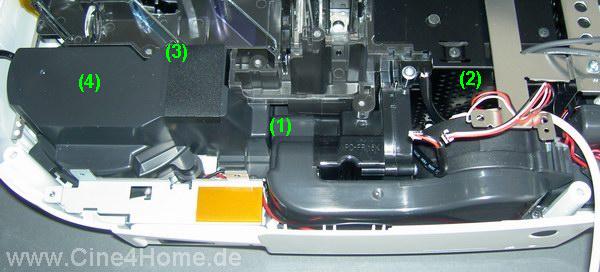
The necessary cooling air is sucked in from the bottom of the machine (1), and the majority is passed directly over to the lamp (2). The remaining part is led towards the optical path (3) where a second fan continues to distribute the air further (4). The "used" air is finally exhausted completely on the front right on the front of the machine, next to the optics:

The lamellas of the exhaust air duct are exemplary positioned diagonally, so no heat waves will disturb the picture. The ventilation is pleasantly quiet, but only in the appropriate picture modes. Unfortunately, the lamp brightness can no longer be controlled by the user as was the case with the TW200, but instead it is coupled to the appropriate picture modes (Film, TV, etc.).
The position of the air cleaning filter on the bottom of the machine is equally impractical. It is easy to exchange, but with a ceiling mounted projector it has to be taken down from its mount.
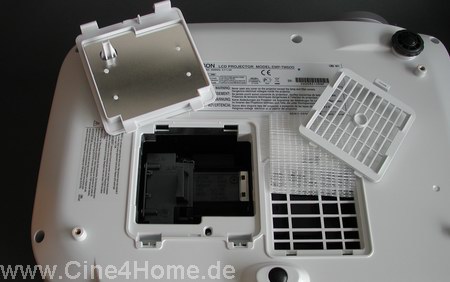
The air filter is on the bottom of the machine,
right next to the lamp pit (to the right)
Considering the fact that the air filter should be cleaned approximately every 100 hours, the elaborate procedure can quickly become annoying. Laterally positioned air filters as can be found on nearly every other LCD projector would have been much more practical.
Altogether, the technical build of the Epson EMP-TW600 / 550 is very well thought through and implemented economically. Except for the ill positioning of the air filters there is not much room for criticism.
1.2 Connections / Signal types (Know How Link here)
The connectors of the projector are located on the back of the machine, as is common with modern home theater projectors. The sunken connection panel a little annoyingly break the flowing lines of the otherwise sleek projector form, but that probably was unavoidable here.

As can be seen in the picture above, the main deficit of its predecessor, the missing digital input, was corrected. With its HDMI input and HDCP support the projector is future proof and "HD-ready". Also analog inputs were not saved on as every connection type has its own connector: 2x Component (YPbPr), 1x S-Video, 1x Composite and 1x RGB H/V are present. The presence of a second component input in the form of a Japanese D4-input is less practical, but included with the projector is a handy D4-Scart-adapter which makes this input very well suited for connection of conventional satellite receivers.
For control signals a Trigger-Out connection as well as an RS232 serial connection are present. The connection types are extremely complete for a projector in this price range, no directly competing model offers more.
1.3 Setup (Know How Link here)
As before, LCD projectors are still lonely at the top concerning placement flexibility. What began with the Sanyo Z1 has established itself as a basic function for current home theater variants: the double lens shift.
The Epson EMP-TW600 / 550 offers a horizontal and a vertical Lens Shift, which can be adjusted using two wheels on the top of the machine.
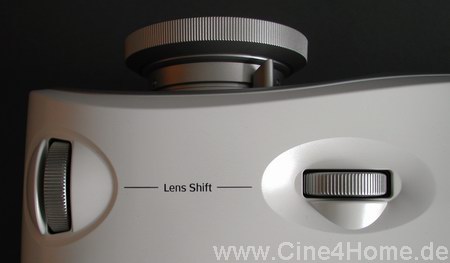
The wheels are not only optically pleasing, but also serve their purpose well. In practical tests it was immediately apparent however that they basically spring back a little, so that it requires a little patience before the picture is aligned properly. Because this has to be done only rarely however, this omission can be forgiven. Once positioned the wheels stay firmly in place because of their heavy turn and do not adjust themselves automatically.
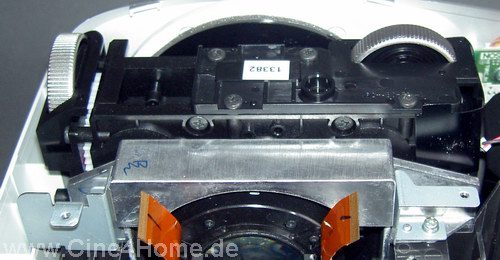
The well-encapsulated Lens Shift mechanics
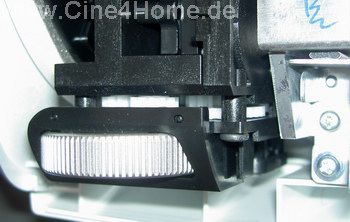
The offered Lens Shift range is exemplary in every way: the picture can be shifted up to half the picture width (50%) horizontally and up to one picture height (100%) vertically without distortion. It should be noted however that when using Lens Shift strongly, the picture sharpness can be affected a little. More on that in our picture review.
At least as important, if not more so is the zoom range of the optics. Only when it offers a large range of adjustment, the desired picture size can be reached in individual room condition. This aspect has not been overlooked by the engineers of the TW600 / 550, as they have blessed the projector with a zoom range which normally shouldn't leave anything to be desired.
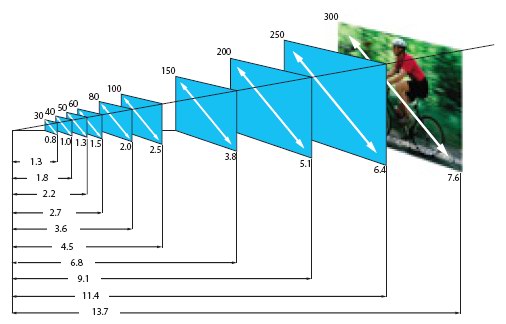
In the diagram above the ratio between picture diagonal (1 inch = 2.54 cm) and the maximum and minimum projection distance are sketched. With a not uncommon picture diagonal of 2.5 meters for instance the TW600 / 550 allows placement between 2.5 meters and 4.5 meters! This is a large range for zoom, and combined with the equally large Lens Shift range provides an uncanny placement flexibility. Hardly any projector is less complicated regarding placement than the TW600 / 550.
Up until now the new Epson EMP-TW600 / 550 showed many improvements compared to its predecessor, but in some areas corners were sadly cut. This concerns mainly luxury features like for instance motorized Zoom and Focus. Both have been replaced by manual adjustment which the user has to do him/herself now. Normally, Zoom and Focus do not have to be adjusted often however, so this drawback can easily be overlooked.
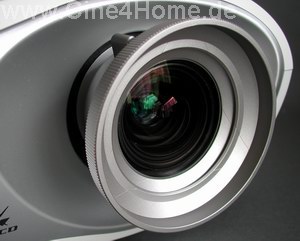
The TW600 / 550 optics are no longer motorized
Somewhat ugly is the plastic-look of the optics, which becomes especially apparent by the clearly visibly ridged ring. Also the dust cap should not be used, as it has to be unpractically wedged into the optics and inevitably leads to an unwanted adjustment of the picture.
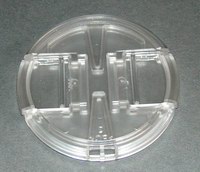
The unpractical dust cap of the TW 600 / 550

It is better to clean the optics manually using an optics brush (available at specialized shops for € 5,-).
2. Operating the projector (Know How Link here)
In the second chapter we want to describe the operation and control of all the offered adjustment options and functions in all detail. In the case of the Epson EMP-TW600 / 550 we view these with one laughing and one crying eye: the projector offers countless exemplary functions, but the presentation is very chaotic.
2.1 Remote Control
Even with the remote control the designers avoided all corners and edges, it is completely rounded. This makes for an unusual design which is not necessarily to everyones taste. It stands out in any case, but evil tongues say it resembles a bone...

Concerning the button layout, the remote control is exemplary: the keys of a theme are grouped in three sections, between them the cursor keys are placed. Especially worth of praise are the direct input selection buttons, allowing the user to directly switch to the desired input source. The remote control has a good grip, all buttons can comfortably be reached with the thumb and the infrared transmitter also functions when reflected off of the screen over larger distances. In addition to all of this, the electric button lighting can be switched on by the press of a button in dark rooms.

The pleasing button backlighting of the remote control
The projector can also be operated without the remote control. On the top
side of the machine there are substantial function keys, clearly arranged:
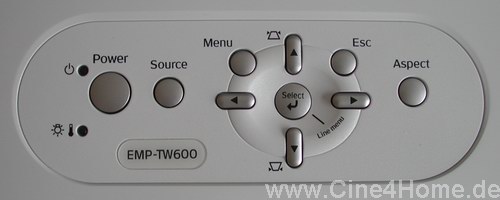
2.2 Menus
As already mentioned, the projector offers an extraordinary number of picture parameters. These are divided into three main groups: "Picture", "Image" and "Settings". By these badly differentiatable designations lies our main point of criticism: the organization without logic. Below we explain the most important functions in detail:
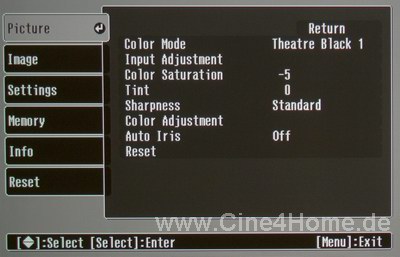
The "Picture"-menu incorporates, as the name implies, different picture parameters. First and foremost is the "Color Mode", which is named a little misleadingly: instead of choosing colors it concerns the selection menu of different factory presets for different application types and room conditions.

The descriptions do a good job in describing the intended application. Of particular interest for home theater projection are the "Theater Black 1/2 " modes. A little unfortunate is the fact that lamp brightness is locked firmly to the factory presets and can not be changed later. Thus for instance there is no Eco-mode for the "Living Room" preset, the projector is audibly louder. More on this in our picture test.
Besides the selectable factory presets the "Picture" menu offers the basic picture parameters such as Tint, Color Saturation, Brightness and Contrast. However the latter ones are hidden in a submenu confusingly named "Input Adjustment".

When the submenu is activated, the reason for this name becomes apparent. Aside from brightness control, also Black and White level can be tuned to the source input. This is quite a useful option which however may confuse many beginners, especially since the difference between White Level and Contrast is not explained very well.

The Sharpness-function also shows a detailed submenu in Advanced mode, in which
video purists can have a field day.
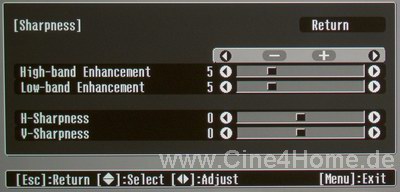
Here the descriptions also seem to be a little too cryptic for the beginner, but thankfully the manual offers a few explaining details. On the whole these detailed adjustment posibilities are extremely worth of praise however, because they are seldom offered on a projector in this price range.
Finally, the "Color Adjustment" menu allows for calibration of the actual color reproduction. Here also a submenu opens on the screen.
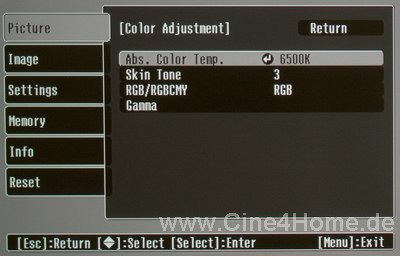
The "Absolute Color Temperature" function is named correctly and offers different choices of preset color temperature presets, the accuracy of witch we'll examine further in the picture test. Even a custom calibration is a possibility by using the normal Gain- and Offset-parameters.
The "Skin Tone" function is an Epson proprietary function which is meant specifically for the correction of skin colors. Indeed it also modifies color temperature and interacts with other color functions, which is why it should not be touched if at all possible and considered to be a marketing gag.
A very praiseworthy function on the contrary is again the "RGB / RGBCMY" function, which allows for the control of the color space.
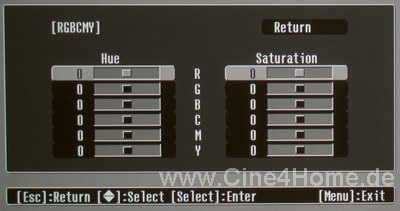
Here, the color tone and saturation can be minutely adjusted for every primary and secondary color. It is a shame however that it is not possible to combine the color temperature settings with the color space correction.
The last option in the "Color Adjustment" menu is the "Gamma" function which is clearly out of place in this section, since Gamma does not correct the colors but the brightness distribution in the picture. The function opens another submenu, which apart from being out of place is absolutely exemplary and even manages to beat the Hitachi TX200 projector.
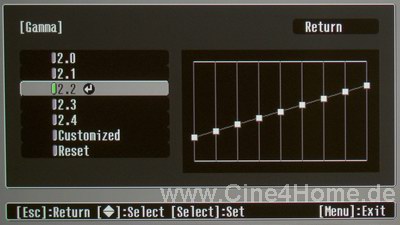
As can be seen in the screenshot above, the gamma curve can precisely be selected from a list. Default settings is the for DVD-mastering normal curve of 2.2. This function alone offers an exemplary adjustment to room conditions.
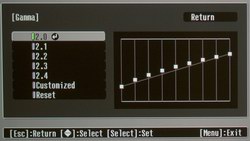

The joining graphics clearly display the different presets.
In addition it is even possible for the user himself to change the brightness distribution using the practical equalizer. The light output in relation to the input signal can be fine tuned at 10 different points. Technically minded users will quickly find value in this mode. But that is not enough: another function allows adjustment of the brightness distribution directly on the live picture. Using a cross hair the user can mark an image detail on the picture and adjust it to the desired coloration. In this way it is made possible to adapt the picture to personal needs without an understanding of all relations between video standards, especially for novices.
The second main group is named "Image", which has no logical difference to "Picture". This is also confirmed by the parameters, which exclusively serve to adjust the picture. An emphasis on picture geometry was probably meant here.
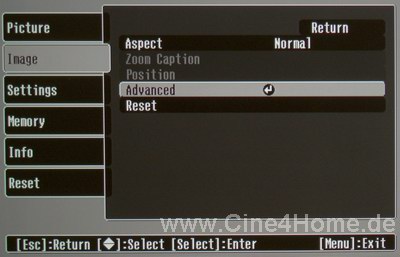
The "Aspect" function incorporates different display formats for the adaption on the input signal. The function can also be recalled from the remote control with a special button.

The selection depends on the source signal.
The again insignificant name "Advanced" opens a further submenu in the Image group, which contains further practical functions:
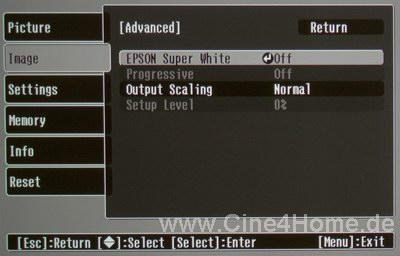
We also classify the "Epson Super White" function in the Marketing Gag category. It should avoid blooming (clipping) of bright picture details and allow for more coloration. In practice it is clear that this function simply lowers the maximum white level. Because such corrections should always be made with the contrast and gamma functions, this feature should not be considered any further.
The "Progressive" mode would have fitted better in a "Signal" group, because it allows for the selection of the desired de-interlacer function (Video or Film).
The award for the most confusing designation again goes to the function "Output Scaling": the overscan can be turned on or off by selection of the settings "Auto", "Normal", and "Larger".
Equally important is the "Setup Level" function, which allows for the adjustment of black level to analog NTSC or PAL sources, and/or between PC- and Video standard on DVI-RGB sources.
Third and last is the "Settings" main group. Here all functions can be found which do not fit in the two picture menus.
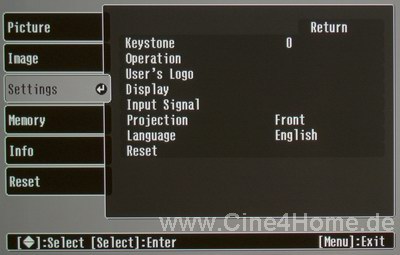
But the first "Keystone" function would already have fitted better in the Image group, which again underlines the very chaotic character of the menu system. The keystone correction allows for a trapezoid picture
"Operation" again opens a completely different submenu with numerous additional functions, which predominantly concern first projector installation:

Especially worth mentioning in the Settings menu is the "Input Signal" function, which allows the programming of the D4 input of the projector. The user can select whether a YPbPr or a RGB source is connected. This allows for the trouble-free RGB connection of a satellite receiver.

As one can see, the parameters of the Epson EMP-TW600 / 550 are numerous, like with hardly any other video projector. Naturally, a memory function to store such a great number of settings is very important, so that not all adjustments have to be done over again. Epson has catered for this.

Nine (!) memory banks are at the users disposal here, again setting a record for the TW600 / 550. With so many storage locations it is possible to set up a profile for every source and every application.
The next to last "Info" group offers an interesting overview of the source signal. Especially worth of praise is the display of the video standard on digital sources (YPbPr \ RGB).
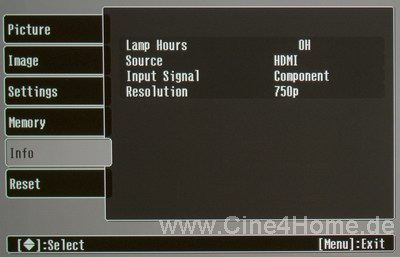
The "Reset" group remains. Here, the lamp counter can be reset to zero and the whole projector can be reset to its factory settings.
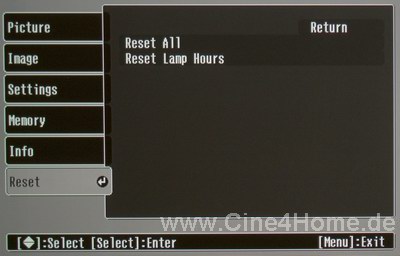
All in all the Epson EMP-TW600 / 550 is very convincing in this section because of
its unbelievable number of adjustment parameters, which allow to get a good
grip on the picture output. The functions are clearly directed at the specialist
due to their very technical designations, so beginners will have some
difficulties to find their way around. But even for experienced home theater
enthusiasts it is difficult: the menu is simply chaotic and requires a little
getting used to before finding a desired function. This was already a problem
with the TW200, which we criticized at the time and still has not been
corrected. Fortunately the remote control creates a remedy here with its many
direct access buttons. Due to the many functions a good impression tips the
scale in operation.
3. Image test
Well designed technical structure, many adjustment options, flexible placement characteristics, until now the TW600 / 550 convincingly impresses in our review. Whether this is the same with the picture quality, our picture review will show now...
3.1 Screendoor / Pixel structure (Know How Link here)
As we already mentioned, all current manufacturers, except Sony, use the current D5 LCD panels from Epson, and of course so does the TW600 / 550. Because of this our observations are always the same in this category:
The new D5 panels should reduce the LCD typical screendoor effect by a decreased pixel distance. And indeed the LCD's show a slightly reduced raster on a close look, but the progress is hardly revolutionary.

The pixel structure of the TW600 / 550 in close up
Because of the high native resolution of the projector, the screendoor effect should not be over-rated however. On a viewing distance of about two times the image width the annoying raster is invisible for most viewers.
3.2 Color Space (Know How Link here)
Digital projectors are getting better from generation to generation. But the demands of the home theater enthusiasts rise accordingly. Was it good enough just a couple of years ago for the picture to appear colorful "somehow", today accurate and at the same time strong colors are on the wishlist of every home theater enthusiast. For some time now there seems to be a comedy-act between the technically achievable and our out-dated video technology. While the latter sets the accurate color reproduction in relation to weak primary colors and a limited color space, current projectors are capable of a much larger color space. This potential is not readily wasted by Japanese engineers, which is reflected in the typical large color space. Especially with Epson the course has changed. While the TW200 was a prime example for accurate color reproduction, its successor TW600 / 550 clearly favorizes a colorful picture representation. On our first look at film material it was immediately apparent what was measured with our color space measurements.
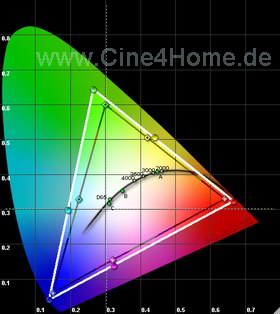
Color Space "Theater Black" / "Theater"
The diagram above shows the color space in the for movie viewing particularly well suited mode "Theater Black". In this mode the color filter, as mentioned in the Technology section, is placed in front of the lamp in order to adjust the lack of red in the light source. As can be seen, the color space of the projector (white triangle) is clearly larger then the color space used by the video standard (dark triangle). This alone is nothing new with LCD projectors and is often also according to the taste of the viewer. In the case of the TW600 / 550 however there is a problem with the secondary colors. These are clearly over-saturated in their representation, which even with a correct color saturation leads to a too colorful picture. Especially in the secondary color Cyan, which shows a shift towards blue in addition to its over-saturation, this behavior is remarkable. As soon as a color in this range is displayed while viewing a movie, it appears almost surreal. Sky colors for instance appear very strong, as if they were re-colorized. In vacation movies this may lift the spirit of the movie, but this does not equal accurate movie representation. This problem is also present in the "Theatre" and "Natural" mode.
Better is the "sRGB"-mode, its color space is very well adjusted to our video standards.
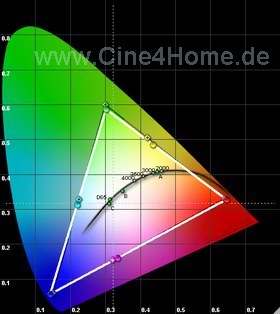
The measurement above shows this preset to be an outstanding factory setting, a pity it can not be recalled in the Theatre-modes. Further adjustment of the sRGB mode is not possible. Unfortunately, the sRGB mode operates with a higher lamp brightness, making the projector audibly louder.
Remaining for review are only the two bright modes of the TW600 / 550, "Dynamic" and "LivingRoom". These presets do not use the internal color filter, allowing the projector to reach its very high maximum brightness of up to 1600 / 550 Lumen. The color spectrum is displayed unfiltered on the screen. As is often the case, the color representation clearly suffers from the high brightness:

Color space "LivingRoom" / "Dynamic"
As can be seen in the diagram, the primary color Green has shifted strongly towards Yellow, which allows the projector to achieve a substantially higher maximum brightness. But this has such a limiting effect on the color space that a perfect color representation is no longer possible. Nevertheless: for television viewing with ambient light, for instance with sports transmissions, the LivingRoom-mode is perfectly suited. Considering the nature of live-transmissions, constantly changing lighting conditions, "accurate" colors are utopian anyway. For DVD movie representation the mode can not be recommended however.
Our measurements of the presets have shown that every one of them is plagued by compromises. But fortunately the engineers have graced us with the unbelievably extensive Picture menu: with appropriate measuring equipment the trained user is able to tune the color space perfectly to the video standard.

After about half an hour of adjustments the result regarding the video standard can be shown.

Color space after tuning
As can be seen in the diagram above, all primary and secondary colors are exactly aligned with the HDTV-standard. The color space is equally congruent. Such an exemplary result can hardly be reached with any other LCD projector in this price range. But unfortunately there is a catch: the Picture menu only allows correction of either the color temperature or the color space. Combining both is not possible. More on this in the next chapter...
3.3 Color Temperature (Know How Link hier)
Besides a well tuned color space a correctly weighting of the primary colors in neutral gray tones and white is inevitable for accurate color representation. Here we have also examined the factory settings of the individual modes.

Color temperature: "TheaterBlack / 6500k"
We start with the preferred mode "Theater Black" with a selected color temperature of 6500K. The measurement above show that the projector comes very close indeed to the by the video standard required color temperature of 6500K / D65. By an excess of blue, which becomes more with diminishing brightness, the picture appears just a little too cool. Too cool color temperatures however are easily forgiven by the eye, so that the factory default above is quite watchable, apart from the blue-peak at 10 to 20 percent brightness.
The next interesting mode is the "sRGB" preset, which already stood out because of its well tuned color space:

Color temperature: "sRGB"
This mode also shows a good approximation to the 6500K-standard, only Red is overemphasized by approximately 15 percent causing the color temperature to appear too warm. Unfortunately an adjustment of the color temperature of the sRGB mode is not possible and the fan noise is increased. For a good film reproduction with accurate colors the mode is still very well suited, thanks to its well tuned color space temperature.
With the "Dynamic" and "LivingRoom" modes no perfect color results can be expected, because of the too limited color space. For the sake of completeness we measured these also however:
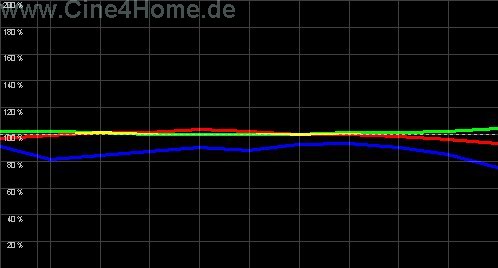
Color temperature: "Dynamic"
The Dynamic mode shows a clear lack of blue, which increases within the dark and bright ranges. As forgiving as our eye is to an excess of blue, as unforgiving it is with a lack of blue: the movie picture appears strangely yellow, all colors lose their natural character. Together with its limited color space, the Dynamic mode is not recommended.
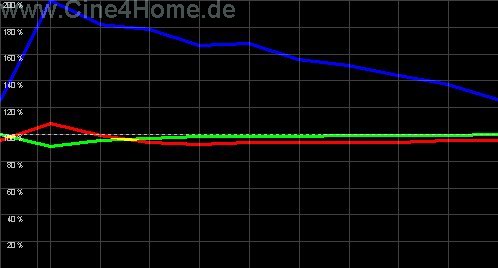
Color temperature: "Living Room"
The LivingRoom mode is quite the contrary: here the lack of blue is replaced by an extreme excess of blue, making the picture representation too cool. In practice the mode is usable for television transmissions in non light controlled rooms due to its immense brightness however.
As with color space the versatile Picture menu of the TW600 / 550 also offers functions for an additional correction of the color temperature. Each color, Red, Green and Blue, can separately be changed in Gain and Offset. With suitable measuring sensors good results can be achieved after only a short amount of time:

Adjusted White balance:
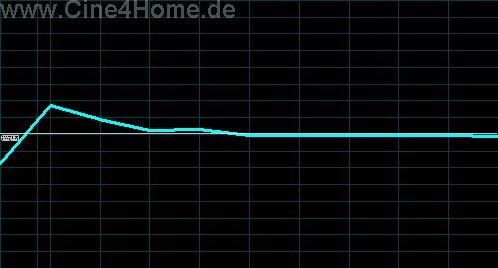
After a few minutes an even color temperature of exactly 6500K / D65 can be
achieved (diagram above). Only the dark ranges below 30% brightness are
difficult to get a grip on with the TW600 / 550, but with more patience it is perhaps
possible to obtain a little bit more precision. Fortunately color shifts are not
very noticable in the dark ranges, so the projector can be forgiven for this
deficiency.
Cine4Home - Calibration tips:
The color space can be tuned to perfection, the color temperature can be equally fine-tuned. All of this looks like the perfectly adjustable projector, if it were not for the already mentioned catch: both optimizations can not be done at the same time. In the Picture menu one must decide between color space or color temperature optimization: at first glance this means you have a choice between a perfect color space with small imperfections in the color temperature or a perfect white balance with an oversaturated color space. We did not find these compromises to be satisfactory, so we decided to search for a solution:
The first attempt is a calibration of the color temperature (see result above) and following that an attempt to optimize the color space. This quickly leads to a dead end however: after adjusting the color temperature only the picture saturation remains as an adjustment option for the color space. This makes the projector too pale however in the color representation.
In our second attempt we fist optimize the color space with the RGBCMY-menu (see 3.2). Once the color space is adjusted to the video standard, the adjustment of the color temperature remains, but it must be done without the use of the Gain and Bias options because they are not available. Fortunately two other picture parameters remain available for the color temperature: "Absolute Color Temperature" and "Skin Tone". With the color temperature adjustment option we adjust white until the excess of blue of the factory settings is compensated. But unfortunately this measure has the annoying side effect that Red slides below its supposed value. This however can be compensated in our review machine by using the "Skin Tone" function. In a certain range it raises Red without shifting blue. Exactly that function we decided to be a marketing gag in our first chapter now helps us with our calibration. Both the color temperature function and "Skin Tone" are linear over the entire brightness range, so that white level is mostly even. The last step is to properly adjust the color saturation.
The end result is a good color tuning in color space, color saturation and color temperature, which does not leave anything to be desired.
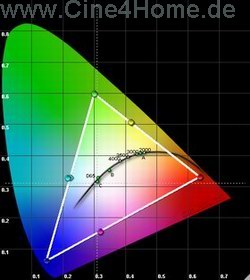
The TW600 / 550 can be calibrated using a few tricks.
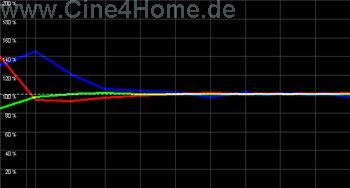
It requires a little creativity, but all in all the TW600 / 550 can be properly
adjusted to the video standard like hardly any other projector in its price
range. On movie viewing the viewer is rewarded with a natural color reproduction
which always displays the picture as accurately as the quality of the DVD (or
another source) allows. The color filter and the many adjustment parameters of
the TW600 / 550 are worth their money here. But even then it would be wishful to be
able to adjust color space and RGB at the same time.
3.4 Luminance tracking / uniformity (Know How Link hier)
A correct color reproduction is half the picture already. At least as important factors however are contrast range and its use in luminance tracking. The gamma influences the brightness distribution in the picture and with a correct setting ensures that every detail in the picture is displayed as bright as was intended when it was recorded. As with colors, a certain standard applies for luminance tracking. Depending upon room and screen size gamma curves between 2,2 and 2,5 are usable. The Epson engineers have exemplary considered this range and offer different curves in the gamma menu: between 2.0 and 2.4. Factory setting is 2.2 which corresponds to the usual DVD mastering.

The various options are absolutely exemplary and allow the user a quick and easy adjustment to his own needs, but only if the recallable presets actually correspond to the promised values. We have measured this and were pleasantly surprised. The 2.2 preset for instance corresponds exactly to a 2.2 gamma curve, without disturbing fluctuations (measured in Theater Black mode).
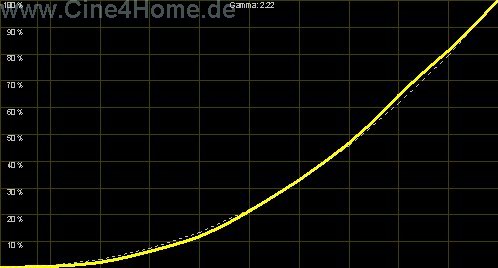
This preset thereby allows a good picture depth, without any elements being under- or overemphasized. The detail in the darker ranges is exemplary, nothing disappears in black. The same applies to the bright ranges. And also the other selectable values correspond exactly to the actual results on the screen.

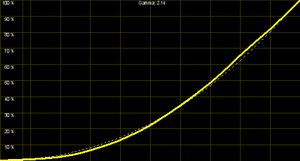
2,04 (left) - 2,14 (right)...
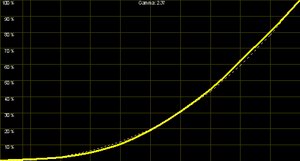
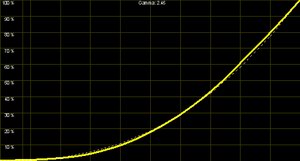
2,37 (left) - 2,46 (right)...
all directly selectable
Due to the factory settings offered here the projector is almost universally applicable. But also the perfectionist, who would like to optimize the luminance tracking in every detail, was thought of. In the "Customized" mode the user can adjust the brightness in nine different points on the curve
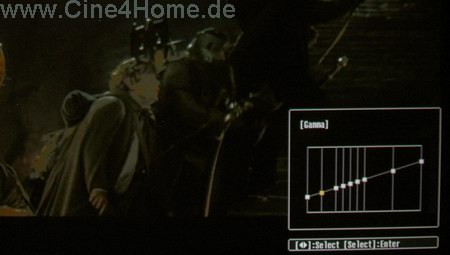
Customized Gamma
The practical thing with this equalizer is the fact that the luminance range to be changed is simultaneously marked in the picture on the screen (see screenshot above). This makes it possible even for the "dummie" to easily recognize the relation between luminance tracking and picture result. It is even possible to select the range to be changed directly in the picture using the cross-hair, if something is not to ones liking.
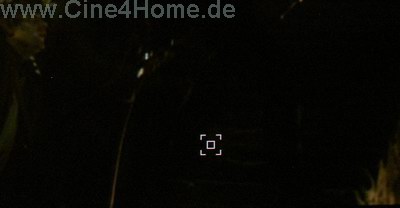
Details too dark?
Simply select the target with the cross-hair and adjust the gamma curve.
The combination of different factory presets, gamma equalizer and marking a portion of the picture is an extraordinary and unique concept, that we have never seen before with any projector. It allows both the avid user as well as the layman to perfectly adjust the picture composition.
Gamma with adaptive iris:
As already described under Technology the Epson EMP-TW600 / 550, as all current LCD
home theater projectors, has an automatic iris, which adjusts the black level to
the current picture content. This technology offers a lot of potential for
picture improvement, but also holds dangers which have to be considered during
the engineering. The main danger of the adaptive iris is a change in luminance
(gamma): because the iris reduces the light output in dark scenes, it can easily
happen for the image to darken overall. This makes its operation noticeable and
the picture content simply too dark in many scenes. Ideally the projector would
make use of an intelligent luminance adjustment, which adjusts the brightness
loss by digital gamma correction. If such a complex system exists, the
adaptive iris is able to increase black level without its operation being
disturbingly visible. Prime example for a powerful adaptive iris system is the
Sony VPL-VW100 (Ruby).
Because of the increasing number of projectors using an adaptive iris, we are increasingly endeavored in our tests to technically examine the system at hand and explain and evaluate its function. In order to gain more knowledge on the iris system, it has to be provoked. This is possible using standard test images, the so-called window-gray patterns. Originally meant for CRT projectors, they show different gray fields on a black background. A modern digital projector "recognizes" the high black portion in the picture and tries to improve the black level using the adaptive iris. Interesting with this is what happens to the gray tones by using the iris: are they simply darkened? does the gamma change? Does the projector lose coloration or do bright details disappear (clipping)? These are all potential side effects of the adaptive iris.
In the case of the TW600 / 550 the engineers apparently have considered the risks and have tried to reduce the compromises by intelligent picture control, in many areas with success:
As already explained under "Technology" the iris is operated by a relatively large stepper motor, which unfortunately is not fast enough to react in real time (50 / 60Hz during vertical blank). This inertia brings the great danger that subsequent darkening or brightening is observed during quick scene changes. This is the reason the engineers have drastically reduced the speed of the adaptive iris. The slower it operates, the more unobtrusive the changes in brightness. The second measure of "cloaking" is a gamma-adjustment, which in the case of the TW600 / 550 succeeded brilliantly. We measured and compared the gamma of individual gray tones with full-screen gray patterns, windowed gray patterns and both with and without adaptive iris, and were astounded how little the iris falsifies here. The gamma's remain almost the same, only black level is adjusted. This is a good quality which can be clarified in a gamma-diagram:

Blue : iris (Full)
Green : iris (Window)
Pink : iris Off
In the diagram above three gamma curves are laid over each other: blue is the curve with activated iris and full-screen gray tones, green is activated iris with windowed gray tones and pink is deactivated iris. In all three cases the measured gamma curves are so close that one can hardly speak of differences. Particularly worth of praise is the fact that within the bright ranges near white no large gamma compression takes place, so the projector does not swallow up bright details with activated iris. On the whole the adaptive iris does not falsify the gamma curve, but limits itself to improving black level. By the way: by improving the black level while retaining the brightness of the picture content, dark details are visibly improved.
3.5 Black level, Contrast, Brightness (Know How Link here)
Since the invention of the adaptive iris the contrast values of current LCD projectors have sky-rocketed. The TW600 / 550 is no exception here: no less than 5000:1 contrast ratio according to its technical data. But in practice these promising values show less improvement than could be expected. Reason for this are not so much the ANSI-contrast as is often mistakenly assumed (it only reaches a fraction of the On/Off contrast with all projectors and can not be used to its fullest in rooms which are not optimized for home theater use), but more the interaction between iris, gamma adjustment and reaction time. The Epson is very convincing in the fist two disciplines, but has a few deficiencies in the third: as already mentioned the iris of the projector closes very slowly, to remain undetected for the eye. The advantage of the inconspicuousness goes at the expense of the response time: it takes no less than 20 seconds for the adaptive iris to close completely on a dark picture. If the projector is given the time necessary, it indeed reaches the fabulous contrast ratio of just about 5500:1, in the case of our review sample even more as the technical data indicates. Thanks to the Cinema color filter this measurement refers to the absolute accurate color temperature of 6500K / D65 in all gray tones and white. When opening the iris reacts a bit faster: it takes about 8 seconds for the iris to open fully with white. The next video perfectly shows a good example of the adaptive iris in action:

The adaptive iris in action...
“Click“ on the image to start the video (.avi)!
Right mouse click to save.
With this high contrast value at D65 the projector impresses with its
data like no other projector. However, because of its slow reaction time the
value is not very telling during movie projection. In practice a dark scene does
not very often last the 20 seconds the iris needs to fully close. In addition,
the black level is not that dark during the transition time and shows the usual
"black gray". The more astounding it is by the way that the slow improvement in black level is not perceived as annoying by the eye during the movie. The whole procedure is very subtle so that the dark scene gradually gains picture quality. To obtain a more realistic contrast ratio measurement, which is much closer to a real environment, we placed a time limit of 6-8 seconds on the adaptive iris, and measured the contrast in the iris position at that time. The TW600 / 550 nevertheless reaches a ratio of 2000:1! The combination of adaptive iris and Cinema filter pays off, except for the Sony HS60 it is visibly above its competition. For users susceptible to noise there is a catch however: the stepper motor of the adaptive iris produces a quiet knocking sound due to its jerky movements, which is enhanced unfortunately by the resonant space of the housing. In quiet scenes the operation of the adaptive iris can be audibly detected therefore (depending upon seating distance), and some prospective buyers have been annoyed by this!
Except for the noise the adaptive iris has only advantages in the case of the TW600 / 550: it improves black level and the details in dark scenes, and allows bright scenes to appear really naturally bright on the screen. In addition the Cinema filter ensures a combination of high contrast and accurate colors. In the projected picture this results in a very good plasticity which offers the viewer a very spacious picture experience. Special highlight of the TW600 / 550 is the light production by means of the E-TORL lamp. With 1600 / 550 Lumen, which our review sample scarcely reached, the projector is also suitable for television viewing in ambient light conditions. In that case however compromises have to be made regarding color space, which is acceptable because of the inaccurate colors of television. Using the color correction of the Cinema filter, the projector loses about 60% of its brightness, but still offers enough brightness for image widths of up to 3 meters. Because of this high brightness the TW600 / 550 is not necessarily for "black fetishists", but we feel the Epson is a good all-round projector for TV reception and movie nights in the living room. Basically it is good for a projector to have more light, because light can be reduced anytime (by gray filters, lamp age etc.), but it is not possible to magically power up failing light reserves!
3.6 Sharpness / Brightness uniformity / convergence (Know How Link hier)
The picture characteristics examined in this section are all dependent of the light path and primarily from the quality of the used optics. Good optics are expensive, which is why deficiencies are not surprising with entry level projectors. The TW600 / 550 is looking good however.
It succeeds especially well in the illumination of the picture. Also in homogeneous gray tones spanning the entire picture there are no for the eye visible brightness losses towards the corners of the screen. The projectors image is perfectly illuminated up to the edges.
Regarding picture sharpness the optics offer solid results, although they are not perfect. When using Lens Shift a little, the picture is equally sharp over the entire area. When using Lens Shift more strongly, we noticed a slight decrease in sharpness towards the edged with our review machine. This is only noticeable with PC-applications however, in normal movie operation this is negligible.
It is a similar story concerning convergence: our review machine showed the for 3-chip projectors typical convergence shift of about 1 pixel, here in the color Red.

Red shifted down by about one HD-pixel
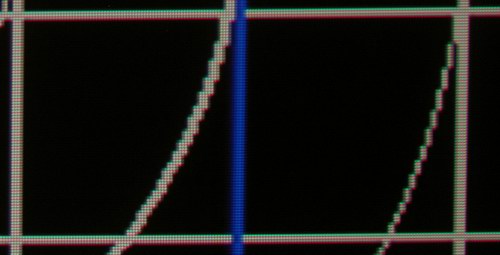
Such small convergence shifts are more noticeable with small writing and
Windows desktops than they are in moving images.
3.7 Overscan (Know How Link here)
In the second chapter we already referred to the switchable overscan, which is hidden under the name "Output Scaling". In the "Normal" mode the projector shows a high overscan of about 40 pixels left and right, and 20 pixels above and down.
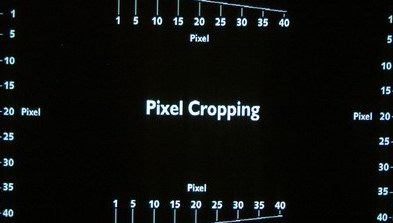
Such a high overscan is tolerable at most for television transmissions, for movie presentation too much picture information is lost however. Cinemascope movies also lose their full 2.35:1 format.
Furtunately, setting "Output Scaling" to "Larger" completely shuts off overscan, the full image content is displayed on the screen without edges being cut off.

The two-step conversion of overscan is not as versatile as that of for instance the Sanyo Z4 or Hitachi TX200, but for most applications it is sufficient. Genuine movie fans prefer overscan to be completely switched off anyway.
3.8 De-Interlacing (Know How Link hier)
In the time of progressive scan DVD-players and the coming HD-standard, it should not play as big a part as a couple of years ago, but as before the de-interlacing of a projector is a factor not to be neglected in the picture reproduction, at least if one wants to watch television now and then. As before all television channels transmit PAL / NTSC-interlaced, and this is not likely to change soon.
Unfortunately the Japanese manufacturers, where NTSC is the official standard, not seldomly neglect the PAL-standard in the programming of the de-interlacer. The TW600 / 550 is no exception here: both with video material (TV-shows, Sports etc.) and movie material (movies) it does not succeed in high quality de-interlacing. We were especially disappointed of the fact that it doesn't even show a high quality Motion Adaptive De-interlacing. Even still pictures showed an annoying edge flare and loss of detail. The mediocre impression is continued with movie material, the projector does not have a film mode suited for PAL.
For occasional television viewing the offered de-interlacing is usable, but for maximum quality there is no avoiding a progressive signal feed using a progressive scan DVD player, satellite receiver, hard disk recorder or scaler. Deficiencies concerning de-interlacing in times where a Faroudja chipset can be found in €200,- DVD players is incomprehensible to us.
3.9 Details / Scaling / Sharpness (Know How Link here)
A high native resolution is not enough to ensure a high picture sharpness with video projection. A high quality signal processing and a powerful scaling are essential with standard definition sources like PAL.
Digital
The extensive Picture menu of the TW600 / 550 permits separate sharpness adjustments for different frequency ranges, horizontally and vertically separated. This allows for an exact tuning on the signal source. But also without lengthy correction the Epson beamer shows considerable results.

Especially pleasing is the lack of any edge-enhancement with digital feeds. This makes the picture appear pleasantly detailed, without being artificially over-sharpened. The excellent image definition is supported by an accurate scaling without any brightness loss in higher frequencies.

When feeding a PAL signal the projector succeeds in adjusting the resolution to its native resolution of 1280 x 720 pixels. Interferences can only be viewed in the critical range of around 6MHz. Also in color resolution the projector shows no large weaknesses.

Up to the highest frequency the color information clearly remains separated from each other. In the verticals the results are also good and ensure a good detail resolution of the picture.

Vertical scaling of typical PAL resolutions

Analog
With analog feeds the EMP-TW600 / 550 shows similarly good results, however tends a
little bit towards double outlines in the picture which can not be removed
completely by the sharpness control.

Slight double outlines with analog feeds
On the whole the signal processing and scaling of the TW600 / 550 offer a
remarkable sharpness even in movie presentation, especially with digital
sources. Small details and fine structures are displayed on the screen clearly
and precisely both in brightness and color. Especially praiseworthy is the
natural sharpness the projector offers, even if it appears "softer" at first glance in a direct comparison with other projectors. Better results with PAL signals can only be obtained by a higher quality scaler.
3.10 Shading (Know How Link here)
Worthy of discussion as before is the color homogeneity of 3-chip projectors. Even high-end projectors like the Sony VPL-VW100 still show "color clouds" on very close examination, at least with test images. To reduce the shading problem a certain factory setting is unavoidable. Fortunately, the manufacturers are increasingly more conscious of their responsibility and deliver the projectors without disturbing color distortions.
In the case of the TW600 / 550 shading is also on a very good level. With our review machine a slight red shift was noticeable in the upper left picture quarter when displaying full image gray tones, but they were so subtle that they could not be noticed during movie presentation. Praiseworthy is the fact that Epson has stored fitting shading corrections for different lamp brightnesses, which are automatically activated on selection of the different modes.
3.11 Vertical Banding
Since the current D5 LCD generation Vertical Banding is not as big an issue as it was last year. Of course panel manufacturer Epson has also done its homework with its own machine: our review machine showed a hint of vertical stripes only in homogeneous gray tones, during movie presentation this was not noticeable at all. Even with football transmissions no annoying vertical banding could be determined.
3.12 HDTV
Current HD-ready projectors like the Epson TW600 / 550 are at their best when they are fed with appropriate material. If this is done, one is rewarded with a picture quality which still astounds us in this price range, even after many projector tests. The picture is highly detailed and sharp, hardly any digital artifacts disturb and in the case of the TW600 / 550, a good picture depth, believable brightness and an exemplary color reproduction even with large image widths add to the already impressive experience. Fortunately the internal de-interlacer handles 1080 HD material better than it does PAL.
3.13 Image Conclusions
In our picture evaluation we have considered both factory settings as well as the attainable picture quality due to the very versatile adjustment options. Ever more specialist dealers pre-calibrate the projector if desired, which in the case of the TW600 / 550 makes a not insignificant difference. You should be well advised on this.
Evaluation picture overall : 1,7 (Gut +) |
|
Black level & contrast |
1,2 (Very Good -) |
Sharpness & Interpolation |
1,6 (Good +) |
Color space & temperature |
1,2 / 1,8 |
De-Interlacing |
3,2 (Satisfactory -) |
Other aspects |
1,6 (Good +) |
(All evaluations refer to their respective kind of
projection and the current state of technology. A direct comparison between
machines is therefore only conditionally possible!)
4. Conclusion
This review has again shown that the LCD projection technology improves from generation to generation, and meanwhile is to be seen as a serious competition for other projection technologies. All current models are extremely versatile, but show different basics in their design. While many competing models are optimized for light controlled rooms, the Epson TW600 / 550 is clearly designed to be a universal projector for both home theater and living room.
This immediately becomes clear by its unusual design, which is mostly targeted at living room integration. Many like the sleek lines in white more than the "silver shoeboxes". The TW600 / 550 shows that a living room is not necessarily ruined by a projector, but possibly eludes a second glance.

Even concerning placement flexibility there were no compromises: with a large zoom range and a large lens shift range, which in addition is well built, the projector can be placed almost anywhere in the room. Unsolvable placement problems are nearly unknown to this projector. Points are deducted only because of its not very quiet and well thought through ventilation, with the air filter being on the bottom of the machine.
The remote control also emits a living room feeling. It is big and offers numerous direct-access functions. Only the on-screen menus do not keep up with this standard, because their structure is far too chaotic. They do however offer an almost endless number of parameters which can be used to optimize image presentation.
Concerning picture quality the factory settings clearly show a focus on occasional living room use: the projector is bright with popping colors and flat gamma, which is beneficial to projection in rooms without light control. The TW600 / 550 is indeed perfectly suited as a replacement of the TV like hardly any other machine in this price range. This is why we award it the title "Living Room Home Theater Projector of the Year". With a machine tuned to such a flexible, we must question the maufacturer, why he so culpably has neglected the de-interlacer. A better de-interlacer, which should nowadays be standard even with entry level machines, saves the customer additional cost for having Progressive Scan feeds. Nevertheless: progressive scan can be added, more light can not. This is why the Epson clearly has an advantage over the competition concerning living room TV.
For those who prefer an optically precise color rendition and reproduction of movie material, there is no way around a certain "tweaking": with its Cinema filter the projector offers optimal conditions for a contrast-rich and at the same time color perfect presentation, but because of the too colorful factory settings, it has to be tweaked a bit. The numerous picture parameters offer endless possibilities, but for perfect colors it takes some patience and know-how to obtain that goal however. Once tuned, the Epson projector convinces by its exemplary picture presentation, which is not only color neutral but also displayed on the screen with enough depth and brightness. Potential for improvement for future models lie primarily with black level. The combination of filter and inconspicuously working adaptive iris is exemplary, only the annoying knocking sounds should have been controlled better.

The good results for LCD-typical artifacts like screendoor, shading and false contour conclude the good impression. There is no doubt, Epson succeeded in producing an appealing universal projector with the EMP-TW600 / Powerlite Cinema 550, which is suited for almost every application and place. In any case it is worth while to take a detailed look at the "TV / Movie allrounder" for yourself at a specialist dealer nearby!
5. Evaluation
+ High contrast thanks to Cinema-Filter
+ Placement flexibility
+ Very high number of adjustment parameters
+ Few LCD Artifacts
+ High maximum brightness
+ Practical gamma manager
+ Good build & features
+ High quality remote control with sufficient grip
- Mediocre de-interlacer
- Chaotic menu structure
- Audible adaptive iris
- Visible pixel structure
- Over saturated secondary colors out-of-the-box
Evaluation overall : 1,5 (Sehr Gut -) |
|
Build & features |
1,3 (Very good -) |
Operation |
2,3 (Good -) |
Technology |
1,3 (Very good -) |
Picture |
1,7 (Good +) |
Price / Performance |
1,0 (Very good) |
(All evaluations refer to their respective kind of projection and the current state of technology. A direct comparison between machines is therefore only conditionally possible!)
22. März, 2006, Ekkehart Schmitt - Translation: Den Walterfang

To the main page of www.Cine4Home.de
6. Technical details (from the manufacturer!):
- Model: Epson EMP-TW600 / 550
- Projection system: RGB 3LCD Panel
- Projection method: Front- / Back- und Ceilingprojection
- LCD: 1,78 cm diagonal; D5 Polysilicon TFT-Active matrix with MLA; 1280 x 720 Pixel; Picture format: 16:9
- Optic system: Manual zoom / focus; F: 2,1 – 2,8; focal point: 21,4 – 31,7 mm; zoom ratio: 1 : 1,5
- Lamp: 170 Watt UHP-Lamp with E-TORL (Epson Twin Optimized Reflector Lamp) Life expectancy: ~3000 Hrs. in lamp mode Low (Color modes: Theater / Theater Black 1 / 2); ~ 1700 Hrs. in lamp mode High (Color modes: Dynamic / LivingRoom / sRGB / Natural / Theater)
- Projection size (Projection distance): 0,6 – 6,1 m wide (0,88 - 9,16 m) with WideAngle; 0,6 – 6,1 m wide; (1,33 – 13,65 m) with Tele
- Lens Shift: Vertically: 100 % max. (up and down) – Horizontally: 50 % max.
- Birghtness: 1600 / 550 ANSI-Lumen (Color mode: Dynamic)
- Contrast: 5000 : 1
- Brightness Uniformity: 85 % (typical)
- Color resolution: (16,77 million colors)
- Color modes: Dynamic; LivingRoom; sRGB; Natural; Theater; Theater Black 1; Theater Black 2
- IR-reception: Right/Left: -30 to +30 degrees; Up/Down: -30 bis +30 Degrees
- Effective Scan-Frequency range (analog): Pixelfrequency: 13,5 to 110 MHz; Horizontally: 15 to 92 KHz; Vertically: 50 to 85 Hz
- Videostandards: 525i / 625i / 525P / 625P / 750P / 1125i;
- Video signal: Component video (Analog Y-level 0,7 V 75 Ohm / Cr Cb-level +/-0,35 V 75 Ohm / Synch. negative 0,3 V or 3-step +/-0,3 V on Y-level) /
- Display resolutions: 1.280 x 1.024 / 1.360 x 768 / 1.024 x 768 / 800 x 600 / 550 / 640 x 480 / 525i / 625i / 525P / 625P / 1.125i
- Native resolution: 1280 x 720
- Inputs: Component, HDMI, S-Video, Composite
- Operation temperature: 5 °C bis 35 °C
- Power: 100-240 V AC ±10 %, 50/60 Hz
- Power consumption: 230 W; Lamp ON: 250 W (High-Brightness-Mode), 200 W (Low-Brightness-Modus); Stand-by mode: 4,5 W
- Dimensions: without feet/max. dimensions: 406 mm (B) x 310 mm (T) x 125 mm (H) / 406 mm (B) x 327 mm (T) x 143 mm (H);
- Weight: 5,2 kg
- Noise level: Silent operation: 26 dB (Color mode: Theater Black 1, Theater Black 2)
- Accessories (delivered with the projector): Powercable (3 m), Remote Control, Accu (LR6 <AA> x 2), SCART-Adapter, User manual